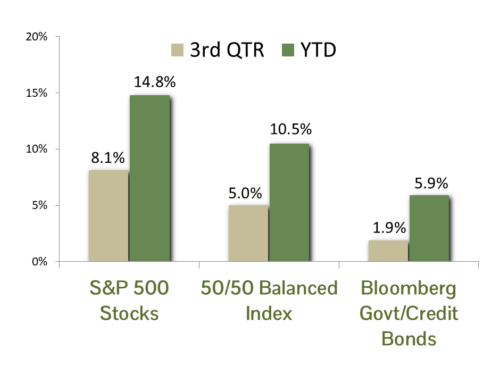Gross Domestic Product (GDP) figures for the first two quarters of 2025 were highly confusing for economists. Taken at face value, the first quarter’s 0.5% decline in GDP and the second quarter’s estimated 3.0% gain, both reported by the U.S. Bureau of Economic Analysis (BEA), indicated a whipsawed U.S. economy. In fact, it was, and the distortions were almost entirely the result of foreign trade. We argue that the quality of the GDP prints were hampered by the historic scale of the import swings and that the true economic growth figure lies roughly in the middle of these two figures. This reveals an economy growing around 1.5% – a clear slowdown from it’s prior trajectory.
Going back to the first quarter of 2025, businesses relying on foreign goods attempted to “front run” the tariffs announced on “Liberation Day” (April 2, 2025) by buying from its foreign suppliers ahead of time and in bulk. Businesses were therefore responsible for a marginal increase in storage costs, yet this still provided the opportunity to avoid the much higher tariffs of 20-50% that were being telegraphed at the time.
In the end, gross imports increased at a staggering 41.3% annualized rate in the first quarter (Source BEA). To avoid double-counting these goods in the GDP calculation, imports are subtracted from GDP, as they have already been accounted for in the consumption and investment measures of economic growth. The final effect on first quarter GDP was to subtract nearly 5% from the figure.
For veteran economists, it is an easy argument that the first quarter’s -0.5% GDP print was not a true indicator of actual economic health; the U.S. consumer was basically fully employed and consumer spending had been trending around 1.5% annual growth. Perhaps a better measure to substitute, then, is the Real Final Sales to Private Domestic Purchasers figure in the GDP calculation. It is the sum of consumer spending and gross private investment. This figure removes much of the statistical noise and is more reflective of actual consumption during the quarter. For the first quarter, the real final sales figure was 1.9%.
Businesses then entered the second quarter with warehouses bursting with goods imported during their first quarter buying binge. As a result, imports declined at a 30.3% annualized rate. This provides a near mirror image of the first quarter’s effect, as this time the decline in imports is added to GDP. In the second quarter the BEA estimated GDP growth of 3.0%, yet the net import figure added over five percentage points and again badly blurred the true economic picture. Referring again to Real Final Sales to Private Domestic Purchasers provides perhaps a truer view, with a figure of 1.2% growth.
At CCM we have discussed the first half dichotomy at length and have decided it best to consider the economy based on its first half 2025 performance, not as two divergent quarters of bust and boom. Basing purely on Real Final Sales to Private Domestic Purchasers, the economy grew at a 1.6% average pace in the first half. Basing on Q1 and Q2 GDP growth versus the year-before figure, the economy has grown at a 1.2% pace. In either case, the U.S. economy is likely growing around 1.5% and has clearly slowed from its 2.7% average growth it enjoyed during 2022-2024. We believe the culprit is uncertainty – which is the bane of both companies and markets. We are hopeful that the recent flurry of trade deals will ease the situation and the economy can return to form.
CCM Investment Advisers, LLC is a Registered Investment Adviser registered with the U.S. Securities and Exchange Commission (CRD# 105743). Any type of investing involves risk of loss and there are no guarantees that the strategies described on this website or any of the associated literature may be successful. The opinions and information contained in this report are for informational purposes only and are not meant to be predictors of future results. Such opinions and information do not constitute an offer or solicitation to provide investment advisory services. Such an offer can only be made in states where CCM Investment Advisers is registered.
Any type of investing involves risk of loss and there are no guarantees that the strategies described may be successful. Any performance data reported represents historical data and future returns may differ significantly. Past performance does not guarantee future results. CCM Investment Advisers does not assume liability for any loss which may result from the reliance by any person upon such information or opinions.
Security, index and economic information are obtained from resources which CCM believes to be accurate but no warrant is made to the accuracy or completeness of the information. Various indices described and discussed herein are unmanaged; investments cannot be made directly into an index. Indices do not incur fees that reduce performance. The performance and volatility of an index or mix of indices will not be the same as a CCM client account.
The S&P 500 Index ® is a readily available, capitalization-weighted index of 500 stocks. The index is designed to measure performance of the broad domestic economy through changes in the aggregate market value of 500 stocks representing all major industries.
Bloomberg Magnificent 7 Total Return Index is an equal-dollar weighted equity benchmark consisting of a fixed basket of 7 widely-traded companies classified in the United States.
The Barclay’s Government/Credit Index is the non-securitized component of the U.S. Aggregate Index. The index includes US Treasuries, government-related issues and corporate bonds.
Corporate bonds returns and U.S. Government bond returns reference the Bloomberg U.S. Corporate Total Return Index and Bloomberg U.S. Government Total Return Index, respectively.
The 50/50 Balanced Index is an index comprised of 50% S&P 500 stocks and 50% Barclay’s Government/Credit Index bonds.
The NASDAQ Composite Index is a readily available, capitalization-weighted index of over 2,500 domestic and international companies listed on the NASDAQ Stock Market.
Equity index valuation and earnings statistics are calculated using the Bloomberg Professional Service unless otherwise indicated.
All blended benchmarks are static blends.
Technical Terms:
Gross Domestic Product (GDP) is the total market value of all final goods and services produced within a country’s borders in a specific time period, usually a year or a quarter.
The Bureau of Economic Analysis (BEA) is a U.S. government agency within the Department of Commerce that serves as the nation’s primary source of accurate and objective economic data.
Real Final Sales to Private Domestic Purchasers (RFS-PDP) is a measure of the value of goods and services produced in an economy by private domestic entities, adjusted for inflation and excluding changes in inventories and government spending. It is calculated as Gross Domestic Product (GDP) minus net exports, minus the change in private inventories, and minus government consumption expenditures and gross investment.



